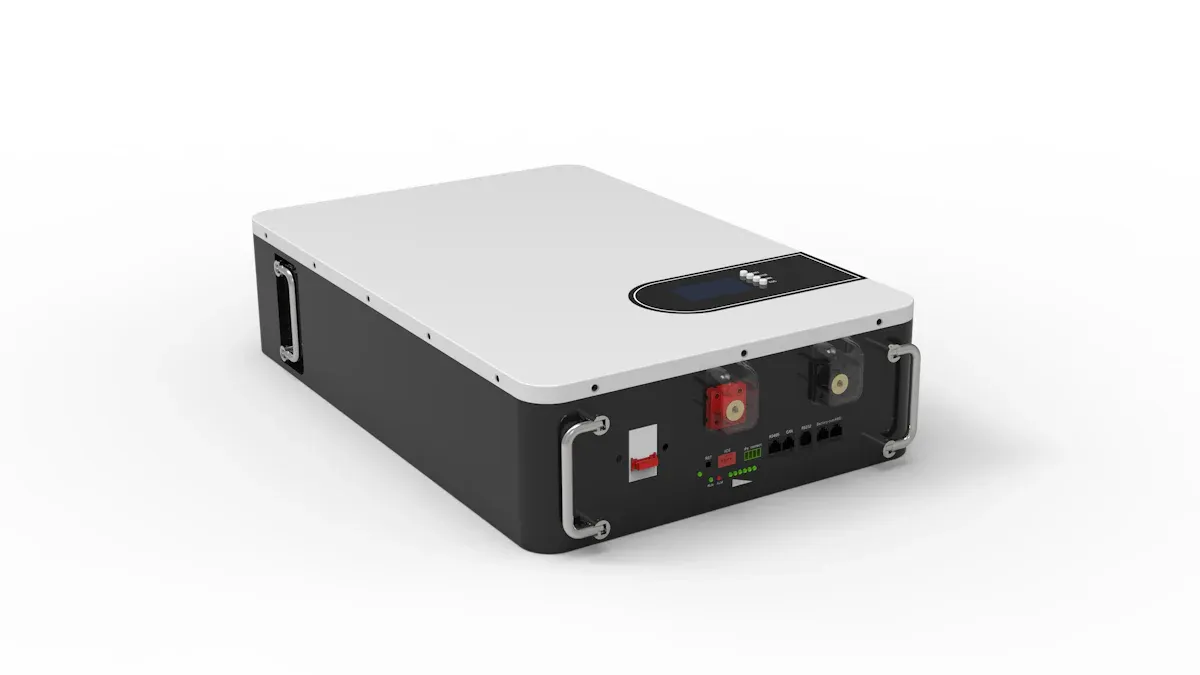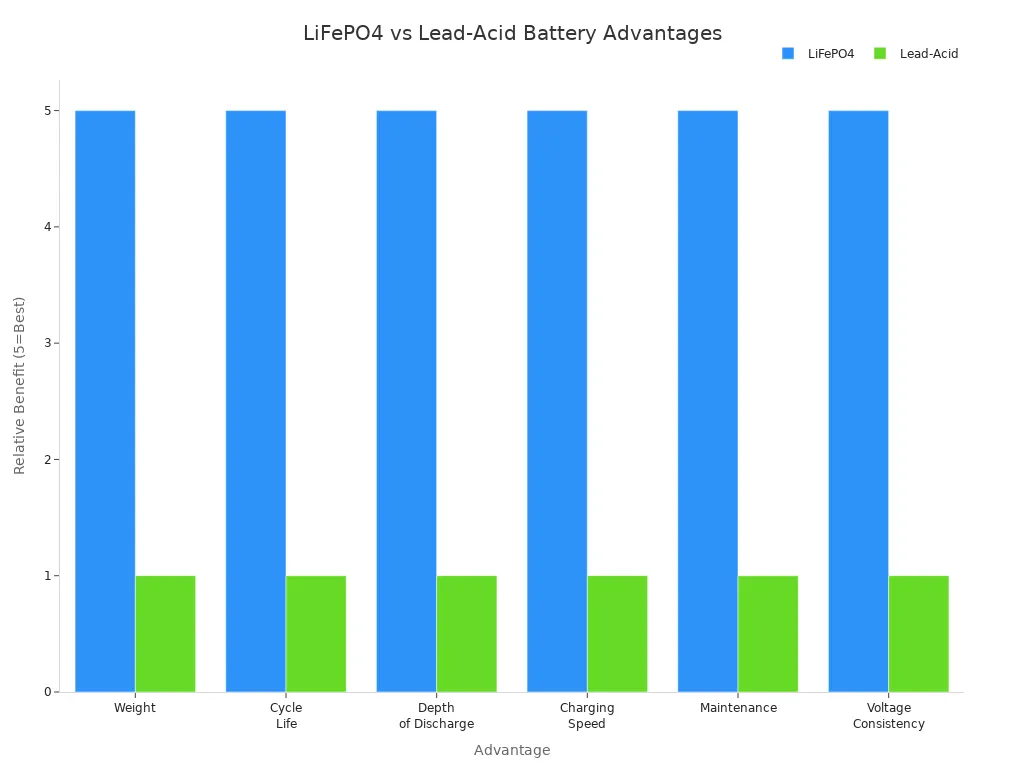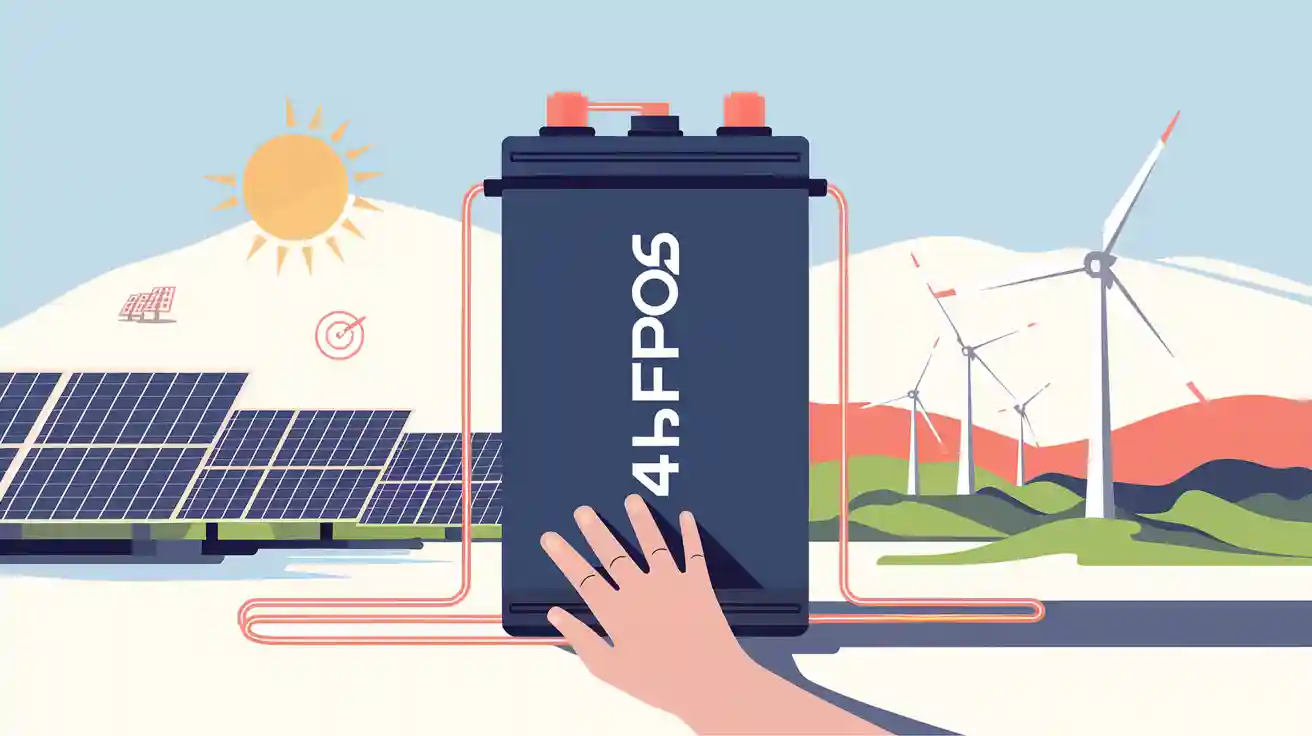Lifepo4 Battery Usage Expands in Renewable Energy Projects
You see lifepo4 battery usage expanding in renewable energy projects because these batteries offer unmatched safety, long cycle life, and excellent heat tolerance. You benefit from lifepo4 batteries in energy storage systems, which help manage the unpredictable nature of solar and wind power. Take a look at how lifepo4 compares to other chemistries:
| Feature | lifepo4 battery | Other Chemistries |
|---|---|---|
| Cycle Life | 2,000–10,000 cycles | 1,000–2,000 cycles |
| Temperature Tolerance | Up to 60°C | Lower |
You also find lifepo4 in electric vehicles, RVs, marine equipment, and 5G base stations. These new applications show how lifepo4 continues to shape the future of energy storage.
Key Takeaways
- Lifepo4 batteries are safe and reliable, making them ideal for renewable energy projects like solar and wind power.
- The demand for Lifepo4 batteries is growing rapidly, with the market expected to reach $35 billion by 2032.
- Prices for Lifepo4 batteries are declining, making them more accessible for both large projects and individual users.
- Lifepo4 batteries have a long cycle life, lasting up to 10,000 cycles, which reduces long-term costs and maintenance.
- These batteries are versatile, used in electric vehicles, RVs, marine equipment, and 5G base stations, showcasing their broad applications.
Lifepo4 Battery Trends
Market Growth
You see lifepo4 battery demand rising quickly in renewable energy projects and many other sectors. The global lithium iron phosphate battery market continues to expand as more people and businesses look for safer, longer-lasting energy storage. You notice this growth in solar farms, wind power systems, electric vehicles, and even backup power for homes and businesses.
- The global LiFePO4 batteries market was valued at $10 billion in 2023.
- By 2032, experts expect the market to reach about $35 billion.
- The compound annual growth rate (CAGR) stands at 15%.
- You see this growth driven by the need for renewable energy solutions and new lifepo4 technology.
The superior safety profile of lithium iron phosphate batteries represents one of the most significant factors driving their increased market share, particularly in applications where thermal runaway risks present unacceptable hazards.
The exceptional cycle life of lithium iron phosphate batteries has emerged as a decisive economic factor in applications where frequent charging and discharging operations make long-term durability a critical performance metric.
The increasing proportion of lithium iron phosphate batteries in the global market has triggered massive investments in manufacturing capacity that are reshaping the geographic distribution of battery production worldwide.
You find lifepo4 battery adoption growing not only in renewable energy but also in electric vehicles, RVs, marine equipment, and 5G base stations. These trends show how lifepo4 technology is changing the way you store and use energy. As lifepo4 battery production increases, you benefit from better products and more choices.
Price Decline
You also notice a steady price decline and accessibility for lifepo4 batteries. This trend makes lifepo4 battery adoption easier for both large projects and individual users. Over the past five years, the price per kWh for lithium batteries has dropped sharply.
- In 2023, the average price per kWh for lithium batteries was $139.
- By 2024, this price fell to $115, a 20% drop in just one year.
- Experts predict that by 2025, prices in leading markets like China could fall below $100 per kWh.
- By 2030, costs may range between $32 and $54 per kWh.
Looking ahead, you can expect lithium battery prices to keep falling. Advances in lifepo4 technology, higher lifepo4 battery production, and lower raw material costs all help drive prices down. By 2030, you may see prices as low as $32 per kWh, along with better energy density and more battery sales.
LiFePO4 batteries not only have a lower initial cost but also offer lower lifetime costs compared to traditional lithium-ion batteries. The estimated lifetime cost for LiFePO4 is between $80 and $200 per kWh, while for other lithium-ion technologies, it ranges from $300 to $600 per kWh.
| Battery Type | Cost per kWh (USD) |
|---|---|
| LiFePO4 | $300 - $600 |
| NMC | $600 - $1000 |
- LiFePO4 batteries are generally less expensive than NMC batteries.
- The cost per kWh for LiFePO4 batteries typically falls in the range of $300 to $600.
- NMC batteries can range from $600 to $1000.
You benefit from these price trends because lifepo4 battery demand keeps rising, and manufacturers respond by increasing lifepo4 battery production. As a result, you get more affordable, reliable, and safe energy storage options. The global lithium iron phosphate battery market will likely keep growing as more people choose lifepo4 for renewable energy and other uses.
Lifepo4 Battery Applications

Renewable Energy Storage
You see lifepo4 battery applications leading the way in energy storage for renewable energy projects. Lifepo4 batteries help you store excess power from solar and wind sources, making electricity available even when the sun sets or the wind stops. You benefit from their reliability and safety, which are essential for both large-scale and residential solar storage systems.
- In 2020, lifepo4 batteries made up 33% of annual battery storage capacity additions.
- By 2023, this share jumped to 84%, showing the growing adoption in renewable energy storage.
You notice lifepo4 batteries in renewable energy storage systems because they offer long cycle life and excellent performance under high temperatures. These features reduce maintenance and cooling costs, making lifepo4 battery applications ideal for grid-scale and residential solar storage.
| Metric | Description |
|---|---|
| Cycle Life | Lifepo4 batteries can endure 2000 to 5000 charge-discharge cycles, ensuring longevity in energy storage systems. |
| High Temperature Performance | These batteries perform better at elevated temperatures compared to other lithium-ion chemistries, reducing cooling needs. |
| Grid Stabilization | They help balance power supply and demand, stabilizing voltage and frequency during peak demand periods. |
| Renewable Energy Integration | Lifepo4 systems store excess energy from solar and wind sources, providing a consistent electricity supply despite intermittency. |
You experience fewer interruptions and more consistent power with lifepo4 batteries in renewable energy. Lifepo4 adoption in residential solar is also rising, giving homeowners a safe and long-lasting solution for backup power.
Electric Vehicles
You find lifepo4 battery applications expanding rapidly in electric vehicles. Lifepo4 batteries offer you a safer and more reliable option compared to other lithium-ion chemistries. You benefit from their exceptional thermal stability, which lowers the risk of overheating and thermal runaway.
| Attribute | Lifepo4 Batteries | Lithium-Ion Batteries |
|---|---|---|
| Safety | Exceptional thermal and chemical stability; low risk of overheating and thermal runaway | Higher energy density but more risk of overheating |
| Lifecycle | Higher cycle life, lasting up to 10 years or more | Shorter lifespan compared to lifepo4 |
| Range | Lower energy density, less range in compact applications | Higher energy density allows for greater range in vehicles |
You may notice that lifepo4 batteries provide a longer lifecycle, often lasting up to a decade or more. While they offer slightly less range due to lower energy density, you gain peace of mind from their safety and reliability. Lifepo4 battery applications in electric vehicles continue to grow as manufacturers seek safer and more sustainable solutions.
RV and Marine Uses
You see lifepo4 battery applications transforming RV and marine power systems. Lifepo4 batteries in these settings give you lighter, longer-lasting, and safer energy storage compared to lead-acid batteries. You enjoy faster charging, minimal maintenance, and consistent voltage, which are crucial for your adventures on the road or water.
- Lifepo4 battery adoption in RV and marine applications is growing by 8–10% each year.
- This increase comes from lower safety risks and enhanced reliability compared to lead-acid batteries.
| Advantage | Lifepo4 Batteries | Lead-Acid Batteries |
|---|---|---|
| Weight | Half the weight of lead-acid | Heavy and bulky |
| Cycle Life | Up to 5,000 cycles | 300–500 cycles |
| Depth of Discharge (DoD) | 100% without damage | About 50% usable capacity |
| Charging Speed | Charges up to 5x faster | Slow charging times |
| Maintenance | Minimal maintenance required | Requires regular maintenance |
| Voltage Consistency | Delivers consistent voltage under load | Performance dips under load |

You get more usable capacity and faster charging with lifepo4 batteries in RVs and boats. Lifepo4 battery applications help you travel farther and spend less time worrying about battery maintenance.
5G Base Stations
You see lifepo4 battery applications powering the next generation of 5G base stations. Lifepo4 batteries meet the technical demands of these installations, providing high energy density, long lifespan, and fast charging. You rely on lifepo4 batteries to keep 5G networks running smoothly, even during power outages.
The demand for lifepo4 batteries in renewable energy and telecom is rising as 5G networks expand worldwide. You benefit from their reliability and efficiency, which are essential for maintaining continuous service.
| Feature | Description |
|---|---|
| Energy Density | Higher than lead-acid batteries, allowing for more energy storage in a compact size. |
| Lifespan | Long cycle life with over 6000 cycles, retaining more than 80% capacity after extensive use. |
| Fast Charging | Capable of quick recovery after power outages, essential for maintaining 5G service continuity. |
| Low Self-Discharge Rate | Retains charge for extended periods, ensuring readiness for backup power when needed. |
| Environmental Friendliness | Does not contain harmful heavy metals, aligning with sustainable practices. |
| Safety Performance | Passes extreme safety tests without fire, explosion, or leakage, ensuring safe operation. |
- High energy density allows for compact installations in urban areas.
- Long lifespan reduces replacement frequency and total ownership costs.
- Fast charging capabilities minimize service disruptions after outages.
- Low self-discharge ensures batteries are ready when needed.
- Environmentally friendly, supporting sustainable development goals.
You notice lifepo4 batteries in renewable energy and telecom because they meet the strict requirements for safety, reliability, and sustainability. Lifepo4 battery applications in 5G base stations help you stay connected and support modern infrastructure.
Tip: You can rely on lifepo4 batteries for efficient charging, long-term durability, and safe operation in every application, from residential solar storage to advanced telecom networks.
Lifepo4 Lithium Battery Pack Innovations

New Chemistries
You see lifepo4 battery technology advancing through new chemistries that boost energy density and cycle life. Researchers focus on improving the lifepo4 lithium battery pack by using engineered electrodes and advanced materials. You benefit from batteries that store more energy in a smaller space and last longer, even under heavy use.
| Feature | Description |
|---|---|
| Energy Density | EVE LiFePO4 Battery Cells offer higher energy density, allowing for more energy storage capacity in a compact design. |
| Cycle Life | These batteries can achieve over 2000 cycles at 100% depth of discharge, indicating extended cycle life. |
| Safety | LiFePO4 chemistry is stable and does not generate heat, reducing the risk of fire or explosion. |
| Application | Suitable for electric vehicles and renewable energy storage due to their reliability and efficiency. |
You notice technological innovations such as graphene additives and high-conductivity materials. These materials improve lithium ion movement and electrochemical performance. Advanced electrolyte formulations help lifepo4 batteries work better in cold weather. You get reliable power in more environments.
| Material/Additive | Benefit |
|---|---|
| Advanced Electrolyte Formulations | Lowers freezing point and reduces viscosity, maintaining ionic conductivity in cold weather. |
| Thermal Stability Enhancers | Creates stable chemical environments, preventing capacity fade in extreme cold. |
| High-Conductivity Materials | Reduces internal resistance, enhancing lithium ion movement for better efficiency. |
| Graphene Additives | Improves electrochemical performance through high surface area and excellent conductivity. |
Battery Management Systems
You rely on battery management systems to keep your lifepo4 lithium battery pack safe and efficient. These systems monitor voltage, current, and temperature. You get protection against overcharging, over-discharging, and overheating. Battery management systems also balance cells, preventing uneven wear and extending battery life.
- Overcharge Protection: Prevents charging beyond safe voltage limits, reducing thermal runaway risk.
- Over-discharge Protection: Cuts off power output when voltage is too low, protecting the battery.
- Temperature Monitoring: Continuously checks battery temperature to prevent overheating.
- Cell Balancing: Ensures even charging and discharging of cells, enhancing longevity.
- Short Circuit Protection: Detects and prevents short circuits, reducing fire hazards.
You see technological innovations in battery management systems, such as AI and machine learning for predictive maintenance. Smart systems provide real-time monitoring and improved thermal management. You benefit from lower long-term costs and safer operation.
Energy Density Improvements
You notice battery technology improving energy density in lifepo4 batteries. Engineered electrodes now achieve 1.5 times higher volumetric energy density than conventional graphite anodes. You get more power in a smaller package.
| Battery Type | Energy Density (Wh/lb) | Energy Density (Wh/kg) |
|---|---|---|
| LiFePO4 | 40-55 | 90-120 |
| Lithium-Ion | 45-120 | 150-220 |
You see research in battery technology focusing on doping, surface modification, and composite cathodes. Silicon-based anodes and lithium metal anodes promise even greater capacity. Thinner separators and improved packing density help maximize energy storage. You benefit from lifepo4 battery packs that deliver more energy, last longer, and perform better in renewable energy projects.
Tip: You can ask questions about battery technology or lifepo4 lithium battery pack innovations to learn how these advances can help your renewable energy system.
Benefits of Lifepo4
Safety
You gain peace of mind with lifepo4 batteries because they meet strict safety standards and pass rigorous tests. These batteries resist thermal runaway, which means they rarely catch fire or explode. You see lifepo4 battery packs certified under UL 9540 and UL 9540A, which test for electrical and fire safety. The table below shows how lifepo4 batteries compare to other types:
| Evidence Type | Description |
|---|---|
| UL 9540 | Tests the entire energy storage system for electrical and fire safety. |
| UL 9540A | Evaluates risk of thermal runaway fire propagation; lifepo4 batteries contain thermal events. |
| Thermal Stability | Lifepo4 batteries have higher thermal stability than NMC batteries. |
| Containment of Thermal Events | Lifepo4 cells withstand forced failures without fire spreading to adjacent cells. |
- Lifepo4 batteries need more energy to start thermal runaway than NMC cells.
- When lifepo4 cells vent hot gas, they rarely ignite, and if they do, the reaction is mild.
- Even in worst-case tests, fires do not spread to other cells.
You benefit from advanced materials and fire-resistant additives in lifepo4 battery electrolytes. These features shield you from current variations and mechanical failures. Researchers continue to improve anode materials and use solid or gel polymer electrolytes to make lifepo4 batteries even safer.
Reliability
You rely on lifepo4 batteries for long-term performance in renewable energy projects. These batteries deliver thousands of cycles before you notice any significant capacity loss. The table below highlights their reliability:
| Metric | Value |
|---|---|
| Cycle Life | Upwards of 2000 cycles |
| Capacity Degradation | Significant after 2000 cycles |
- Lifepo4 batteries last over 6,000 cycles at 90% depth of discharge.
- You see round-trip efficiencies above 95%.
- Lifepo4 batteries withstand 2,000 to 5,000 cycles before losing much capacity.
You use lifepo4 batteries in harsh environments because they operate up to 60°C (140°F) without overheating. In cold climates, lifepo4 batteries work at temperatures as low as -20°C (-4°F), outperforming lead-acid and nickel-based batteries. Their wide temperature range ensures you get stable energy output, which is vital for renewable energy storage.
Sustainability
You support sustainability goals when you choose lifepo4 batteries for your energy projects. These batteries help you store energy from solar and wind, making renewable sources more reliable. Lifepo4 battery recycling reduces environmental impact and promotes resource conservation. The lifecycle analysis of lifepo4 batteries shows that most environmental penalties come from electrode production, which accounts for over 70% of the impact. Researchers recommend using recycled materials to lower this footprint.
- Lifepo4 batteries enhance energy storage, helping you manage the ups and downs of renewable energy.
- Their long cycle life and stability support a consistent energy supply.
- Lifepo4 batteries stabilize the electricity system, improving efficiency.
- You gain energy independence and cost savings by integrating lifepo4 batteries with solar panels.
- Lifepo4 battery recycling programs continue to grow, making these batteries a greener choice.
Tip: You can ask about lifepo4 battery recycling options to make your energy system even more sustainable.
Future Outlook
Emerging Applications
You will see lifepo4 batteries powering more areas in the next five years. These batteries play a key role in energy storage for solar and wind systems. Their ability to handle high discharge rates and work in different temperatures makes them a top choice for energy storage. You also notice lifepo4 batteries gaining ground in electric vehicles. The automotive industry values their safety and long cycle life, which can reach over 2,000 charging cycles. Research and development teams continue to improve lifepo4 battery performance, especially with new polymeric electrolytes. These advances help lifepo4 batteries compete with new technologies like solid-state batteries.
- Renewable energy storage systems
- Electric vehicles
- Research and development for better battery materials
Challenges
You face several challenges when adopting lifepo4 batteries for energy storage. The table below shows some of the main issues:
| Challenge | Description |
|---|---|
| Cost and Energy Density | Lifepo4 batteries have lower energy density (90–110 Wh/kg) compared to NMC (200 Wh/kg). |
| Recycling Infrastructure | Disposal challenges hinder market expansion, despite advancements in manufacturing reducing costs. |
| Temperature Sensitivity | Performance declines in extreme temperatures, affecting applications in diverse climates. |
You may also find high upfront costs for quality batteries. Variable electricity rates can make it harder to see quick savings. Many small projects struggle because they do not get enough government support. Outdated regulations slow down the process of adding lifepo4 battery systems to energy storage projects. These rules often do not match the speed of new technology, which can delay your plans.
Research Focus
You see researchers working hard to improve lifepo4 battery technology. Their main goals include better performance, stronger safety features, and greater environmental sustainability. Scientists test new materials and electrode chemistries to boost energy density and speed up charging. They also look for non-toxic materials to reduce harm to the environment. Major breakthroughs in battery safety have already lowered the risk of thermal runaway. Many teams now focus on solid-state batteries to prevent fire hazards. You benefit from these efforts as lifepo4 batteries become safer, greener, and more powerful for energy storage in the future.
Note: You can expect lifepo4 battery research to keep pushing the limits of safety, performance, and sustainability. This will help you get the most out of your energy storage systems.
You see lifepo4 battery solutions expanding because lifepo4 offers safety, reliability, and sustainability for renewable energy projects. Lifepo4 supports long-term growth with innovations in energy density and battery management. If you consider lifepo4 for your project, review expert recommendations:
| Recommendation | Description |
|---|---|
| Project Consultation | Get tailored lifepo4 solutions for your renewable energy needs. |
| Installation Support | Use professional help for seamless lifepo4 integration. |
| Long-term Technical Service | Rely on ongoing support to keep your lifepo4 system running smoothly. |
| Compliance with Standards | Choose lifepo4 products that meet CE, UN38.3, and ISO standards. |
You can expect lifepo4 to play a bigger role in future energy systems as technology improves.
-

 May.2025.11.24Ternary Lithium Battery vs Lithium-ion: Complete Comparison Guide (2025 Edition)Learn More
May.2025.11.24Ternary Lithium Battery vs Lithium-ion: Complete Comparison Guide (2025 Edition)Learn More -

 May.2025.11.214S2P 18650 14.8V Battery: Complete Technical Guide, Specs, Applications & SafetyLearn More
May.2025.11.214S2P 18650 14.8V Battery: Complete Technical Guide, Specs, Applications & SafetyLearn More -

 May.2025.11.18PCM vs BMS in Lithium Batteries: What’s the Difference and Which One Do You Need?Learn More
May.2025.11.18PCM vs BMS in Lithium Batteries: What’s the Difference and Which One Do You Need?Learn More -

 May.2025.11.17Custom Li-ion Battery Design for Medical Devices (2025 Comprehensive Guide)Learn More
May.2025.11.17Custom Li-ion Battery Design for Medical Devices (2025 Comprehensive Guide)Learn More -

 May.2025.11.17The Future of Lithium-Ion Batteries: Innovation, Sustainability, and Global Market TrendsLearn More
May.2025.11.17The Future of Lithium-Ion Batteries: Innovation, Sustainability, and Global Market TrendsLearn More
















